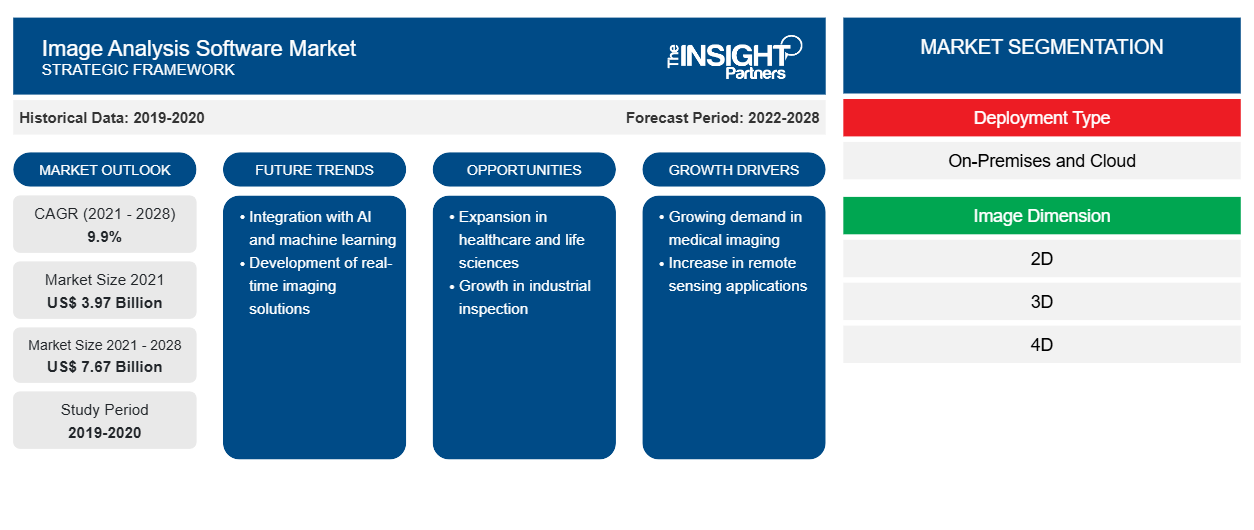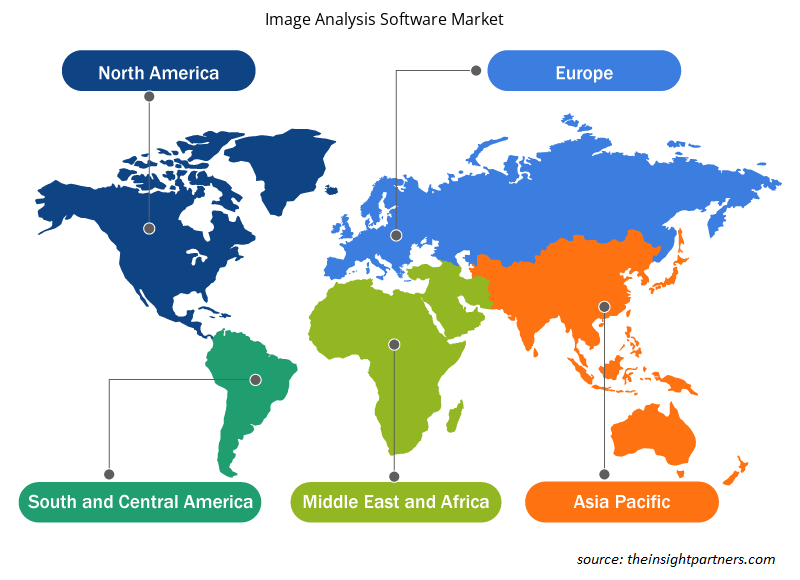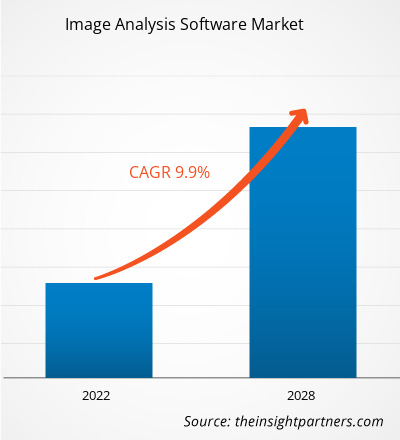[Research Report] The image analysis software market is expected to grow from US$ 3,970.93 million in 2021 to US$ 7,672.16 million by 2028; it is estimated to grow at a CAGR of 9.9% from 2021 to 2028.
Image analysis software market, often known as imagery analysis market, aids in the extraction of valuable data from pictures, mostly digital images, using digital image processing techniques. Image analysis tasks can range from as simple as scanning barcoded tags to as complex as facial recognition of a person. Computers are required to process vast volumes of data, jobs requiring complicated computing, and the extraction of quantitative data. When a computer or electrical equipment analyzes a picture to extract usable information, it is known as digital image analysis or computer image analysis. It incorporates pattern recognition, digital geometry, and signal processing into the domains of computer or machine vision and medical imaging.
Image analysis software applications powered by Artificial Intelligence (AI) and Machine Learning (ML) redefine the automotive industry. It is now being used in the automobile manufacturing industry in design, supply chain, production, and post-production. Furthermore, AI and machine learning are being used in 'driving assistance' and 'driver risk assessment' systems, revolutionizing the transportation industry. Artificial intelligence is also changing various aftermarket services, such as predictive maintenance and insurance. In the automobile business, machine learning has resulted in developing new intelligent products and improved working methods.
Finding forms, recognizing edges, reducing noise, counting objects, and generating statistics for texture analysis or picture quality are all examples of image analysis tasks. It is the quantitative or qualitative characterization of digital pictures in two dimensions (2D) or three dimensions (3D), wherein computer vision analyzes 2D pictures, while medical imaging analyzes 3D images. The image analysis software is widely used in the microscopes image analysis and study the scientific images. The image analysis software market growth is mainly driven by the vast adoption of the software in the healthcare and life science industry.
Customize This Report To Suit Your Requirement
You will get customization on any report - free of charge - including parts of this report, or country-level analysis, Excel Data pack, as well as avail great offers and discounts for start-ups & universities
Image Analysis Software Market: Strategic Insights

- Get Top Key Market Trends of this report.This FREE sample will include data analysis, ranging from market trends to estimates and forecasts.
You will get customization on any report - free of charge - including parts of this report, or country-level analysis, Excel Data pack, as well as avail great offers and discounts for start-ups & universities
Image Analysis Software Market: Strategic Insights

- Get Top Key Market Trends of this report.This FREE sample will include data analysis, ranging from market trends to estimates and forecasts.
Impact of COVID-19 Pandemic on Image Analysis Software Market
The COVID-19 pandemic has benefited the image analysis software market. Businesses face new challenges due to the COVID-19 pandemic and the development of remote work environments. The COVID-19 outbreak has highlighted the necessity of companies in various industries to adopt digital technologies and leverage the potential of image analysis software market solutions and services to optimize operations and costs, which will further increase ROI on IT tools. Further, the pandemic arrival in 2020 prompted a slew of challenges for global image analysis software market operations. Healthcare infrastructures in developed economies is collapsed due to the rising cases of COVID-19. Therefore, public healthcare emergency requires the government and market players to intervene and assist in the revival of image analysis software market operations and revenue through collaborative efforts of research and development initiatives undertaken to recover the losses during the forecast period. In addition, the increased investments bode well for the image analysis software market in the following years.
Image Analysis Software Market Insight
Growing Demand for Image Analysis-Enabled Security Applications and Products
Companies have started to see the potential for deriving resources from unstructured data. They can use photos or videos to create a unique and engaging consumer experience in retail, entertainment, insurance claims, and other industries. Image analysis is used to support an increasing number of corporate use cases. These practical applications of deep learning and image analysis result from advancements in machine learning algorithms, the availability of datasets, and the existence of robust technology with platforms that allow real-time processing. Many airports in the United States are upgrading their equipment to enable biometrics such as finger or iris scanning as an alternative security screening technique. Companies anticipate significantly increasing capacity by deploying image analysis technology to transfer passengers from arrival through security to their departure gate.
Image Analysis Software Market - Deployment Type Segment Insights
Based on deployment, the image analysis software market is bifurcated into on-premises and cloud. On-premises software is installed and operated on computers on the user's or organization's premises rather than at a remote facility, such as a server farm or cloud. As on-premise software provides better flexibility, stability, and security, several market players are now selling on-premises software. For instance, On-Premises Imagga's visual AI solutions are available for full deployment on a company's private, local servers. Data-sensitive organizations may use Imagga's award-winning visual A.I. technology to perform auto-tagging, auto-categorizing, color extraction, custom training, and facial recognition while remaining fully compliant with privacy laws and regulations.
Image Analysis Software Market - Image Dimension Segment Insights
Based on image dimension, the image analysis software market is segmented into 2D, 3D, and 4D. 2D image is created by using the x and y-axis. Traditionally, 2D images have been used as a source of animation and video. It is an older technology with a long history, yet it is still a classic for a reason. These images are simple, visually appealing, and easy to consume without being too overwhelming or disturbing to customers. 2D images are common in animation and video games because they provide a realistic yet flat perspective of movement on the screen. Thus, several businesses in the industry are now offering software to analyze 2D photos. For instance, Image-Pro Plus 2D Image Analysis Software by Media Cybernetics, Inc. helps simply gather photographs, count, measure, and classify items, and automate the job. Microscope control, image capture, measurement, count/size, and macro development capabilities are all included in this software package.
Image Analysis Software Market - Industry Vertical Segment Insights
Based on industry vertical, the image analysis software market is segmented into healthcare and life science, manufacturing, academia, minerals, metals and oil, and others. In medical industry, image analysis software is useful in various fields such as neurology, cardiology, orthopedics, dentistry, and oncology. The software can read images created by X-rays, MRIs, CT scans, PET scans, and ultrasounds. As a result, processes can be automated and accelerated to avoid manual work and save time. The software may learn to recognize specific features in these photographs, making the diagnosis procedure quick and accurate. Medical image processing software has a lot of capabilities. AI-based solutions detect irregularities and potentially dangerous anomalies and also show if the patient is dealing with cancer or a benign tumor. The software can read 3D and so-called 4D photos in addition to regular 2D images (ones that display changes in time).
Image Analysis Software Market
The image analysis software market players focus on new product innovations and developments by integrating advanced technologies and features to compete. In October 2021, Clemex Vision included unique instructions for martensitic, ferritic, and austenitic grains, as well as ML capabilities. These new automatic methods have been added into the existing software's toolbox to provide a quick and accurate technique of visually identifying difficult microstructures.
Based on deployment type, the image analysis software market is bifurcated into on-premises and cloud. Based on image dimension, the image analysis software market is segmented into 2D, 3D, and 4D. By industry vertical, the image analysis software market is segmented into healthcare and life science, manufacturing, academia, minerals, metals and oil, and others. Based on region, the global image analysis software market is segmented into North America, Europe, Asia Pacific, Middle East & Africa, and South America.
Image Analysis Software Market Regional Insights
The regional trends and factors influencing the Image Analysis Software Market throughout the forecast period have been thoroughly explained by the analysts at The Insight Partners. This section also discusses Image Analysis Software Market segments and geography across North America, Europe, Asia Pacific, Middle East and Africa, and South and Central America.

- Get the Regional Specific Data for Image Analysis Software Market
Image Analysis Software Market Report Scope
| Report Attribute | Details |
|---|---|
| Market size in 2021 | US$ 3.97 Billion |
| Market Size by 2028 | US$ 7.67 Billion |
| Global CAGR (2021 - 2028) | 9.9% |
| Historical Data | 2019-2020 |
| Forecast period | 2022-2028 |
| Segments Covered |
By Deployment Type
|
| Regions and Countries Covered | North America
|
| Market leaders and key company profiles |
Image Analysis Software Market Players Density: Understanding Its Impact on Business Dynamics
The Image Analysis Software Market is growing rapidly, driven by increasing end-user demand due to factors such as evolving consumer preferences, technological advancements, and greater awareness of the product's benefits. As demand rises, businesses are expanding their offerings, innovating to meet consumer needs, and capitalizing on emerging trends, which further fuels market growth.
Market players density refers to the distribution of firms or companies operating within a particular market or industry. It indicates how many competitors (market players) are present in a given market space relative to its size or total market value.
Major Companies operating in the Image Analysis Software Market are:
- ADCIS SA
- Bio-Rad Laboratories, Inc.
- Oxford Instruments
- Clemex Technologies, Inc.
- Media Cybernetics, Inc.
Disclaimer: The companies listed above are not ranked in any particular order.

- Get the Image Analysis Software Market top key players overview
Image Analysis Software Market – Company Profiles
- ADCIS SA
- Bio-Rad Laboratories, Inc.
- Oxford Instruments
- Clemex Technologies, Inc.
- Media Cybernetics, Inc.
- MIPAR Software LLC
- Olympus Corporation
- Pax-it
- PerkinElmer, Inc.
- TissueGnostics GmbH
- Leica Microsystems GmbH
- MVTec Software GmbH
- Carl Zeiss AG
- Scale AI, Inc.
- Labelbox, Inc
- V7 Ltd
Frequently Asked Questions
Which region has the largest market share in the image analysis software market?
North America held the largest market share in year 2020, along with the notable revenue generation opportunities in Europe and APAC.
Who are the major vendors in the image analysis software market?
Key companies in the image analysis software market include ADCIS SA; Bio-Rad Laboratories, Inc.; Oxford Instruments; Clemex Technologies, Inc.; Media Cybernetics, Inc.; MIPAR Software LLC; Olympus Corporation; Pax-it; PerkinElmer, Inc.; TissueGnostics GmbH; Leica Microsystems GmbH; MVTec Software GmbH; Carl Zeiss AG; Scale AI, Inc.; Labelbox, Inc; and V7 Ltd.
Which deployment type-based segment has the largest market share in 2020?
The Image analysis software market is segmented into on-premises and cloud based on the deployment type. The global image analysis software market is dominated by on-premise segment in 2020, which accounted for more than ~ 60%.
What is the future trend for image analysis software market?
Visual AI allows new and experienced users to effortlessly construct and deploy more accurate and explicable machine learning models with photos through community hardware. Computer vision will enable users to manipulate pictures as they would any other type of data. Enterprise AI systems automate the preparation, selection, and training of a wide range of cutting-edge deep learning models so that the optimal deployment model may be recommended. As social separation becomes the new normal, it's more important than ever to watch and monitor people's gatherings and movements. Standard Operating Procedures (SOPs) must be implemented and tracked in real-time by businesses. Employees can maintain safe, specified distances from one another throughout shifts while following conventional practices thanks to computer algorithms that evaluate data from on-site video cameras. Retailers may utilize AI and machine learning tools to keep track of the distances between their warehouse employees. When a divergence from typical behavior is detected, these tools issue real-time alerts., which in turn is likely to gain momentum for the image analysis software market over the forecasted period.
What are the market opportunities for image analysis software market?
AI is becoming the next frontier in digital transformation, and when integrated into processes, it can deliver value and impact across all facets of a company. AWS, Microsoft, and Google are all aggressively investing in improving their image analysis software solutions to improve in-store and online retail performance. Due to the emergence of COVID-19, demand for cloud-based services has increased even more. Intelligence Retail, a supplier of computer vision and AI for merchandising solutions, uses IBM's cloud and analysis solution, which includes cutting-edge Graphics Processing Units (GPUs), to help businesses increase sales, lower audit costs, improve performance, and increase customer loyalty. For example, Trax and Google Cloud teamed in 2019 to use Google's cloud and edge computing technologies, as well as Trax's image recognition and machine learning capabilities, to successfully manage in-store inventory and every SKU on the shelf with actionable real-time insights. These strategies would promote the future growth of the image analysis market in the forecasted period.
What are the driving factors responsible for the growth of image analysis software market?
Growing demand for image analysis-enabled security applications and products
Increasing demand for image analysis in the automotive industry
- Historical Analysis (2 Years), Base Year, Forecast (7 Years) with CAGR
- PEST and SWOT Analysis
- Market Size Value / Volume - Global, Regional, Country
- Industry and Competitive Landscape
- Excel Dataset
- Parking Meter Apps Market
- eSIM Market
- Advanced Distributed Management System Market
- Online Exam Proctoring Market
- Electronic Data Interchange Market
- Barcode Software Market
- Maritime Analytics Market
- Cloud Manufacturing Execution System (MES) Market
- Robotic Process Automation Market
- Digital Signature Market
Testimonials
Reason to Buy
- Informed Decision-Making
- Understanding Market Dynamics
- Competitive Analysis
- Identifying Emerging Markets
- Customer Insights
- Market Forecasts
- Risk Mitigation
- Boosting Operational Efficiency
- Strategic Planning
- Investment Justification
- Tracking Industry Innovations
- Aligning with Regulatory Trends
Yes! We provide a free sample of the report, which includes Report Scope (Table of Contents), report structure, and selected insights to help you assess the value of the full report. Please click on the "Download Sample" button or contact us to receive your copy.
Absolutely — analyst assistance is part of the package. You can connect with our analyst post-purchase to clarify report insights, methodology or discuss how the findings apply to your business needs.
Once your order is successfully placed, you will receive a confirmation email along with your invoice.
• For published reports: You’ll receive access to the report within 4–6 working hours via a secured email sent to your email.
• For upcoming reports: Your order will be recorded as a pre-booking. Our team will share the estimated release date and keep you informed of any updates. As soon as the report is published, it will be delivered to your registered email.
We offer customization options to align the report with your specific objectives. Whether you need deeper insights into a particular region, industry segment, competitor analysis, or data cut, our research team can tailor the report accordingly. Please share your requirements with us, and we’ll be happy to provide a customized proposal or scope.
The report is available in either PDF format or as an Excel dataset, depending on the license you choose.
The PDF version provides the full analysis and visuals in a ready-to-read format. The Excel dataset includes all underlying data tables for easy manipulation and further analysis.
Please review the license options at checkout or contact us to confirm which formats are included with your purchase.
Our payment process is fully secure and PCI-DSS compliant.
We use trusted and encrypted payment gateways to ensure that all transactions are protected with industry-standard SSL encryption. Your payment details are never stored on our servers and are handled securely by certified third-party processors.
You can make your purchase with confidence, knowing your personal and financial information is safe with us.
Yes, we do offer special pricing for bulk purchases.
If you're interested in purchasing multiple reports, we’re happy to provide a customized bundle offer or volume-based discount tailored to your needs. Please contact our sales team with the list of reports you’re considering, and we’ll share a personalized quote.
Yes, absolutely.
Our team is available to help you make an informed decision. Whether you have questions about the report’s scope, methodology, customization options, or which license suits you best, we’re here to assist. Please reach out to us at sales@theinsightpartners.com, and one of our representatives will get in touch promptly.
Yes, a billing invoice will be automatically generated and sent to your registered email upon successful completion of your purchase.
If you need the invoice in a specific format or require additional details (such as company name, GST, or VAT information), feel free to contact us, and we’ll be happy to assist.
Yes, certainly.
If you encounter any difficulties accessing or receiving your report, our support team is ready to assist you. Simply reach out to us via email or live chat with your order information, and we’ll ensure the issue is resolved quickly so you can access your report without interruption.















The List of Companies - Image Analysis Software Market
- ADCIS SA
- Bio-Rad Laboratories, Inc.
- Oxford Instruments
- Clemex Technologies, Inc.
- Media Cybernetics, Inc.
- MIPAR Software LLC
- Olympus Corporation
- Pax-it
- PerkinElmer, Inc.
- TissueGnostics GmbH
- Leica Microsystems GmbH
- MVTec Software GmbH
- Carl Zeiss AG
- Scale AI, Inc.
- Labelbox, Inc
- V7 Ltd






 Get Free Sample For
Get Free Sample For